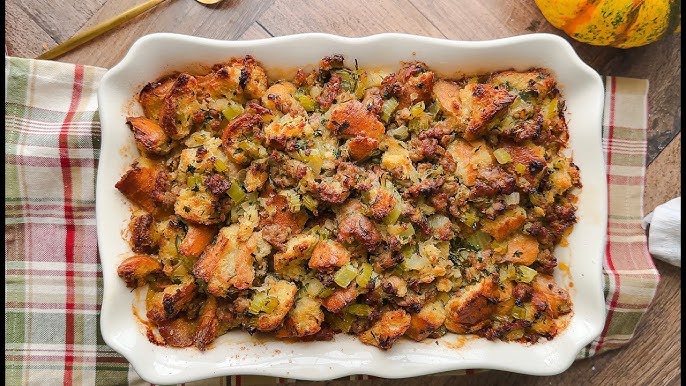Sausage Stuffing Recipe: Stuffing is a classic side dish that often steals the show at holiday dinners and family gatherings. It’s warm, savory, and loaded with comforting flavors. Adding sausage to traditional stuffing takes it to a whole new level—rich, hearty, and irresistibly delicious.
What is Sausage Stuffing?
Sausage stuffing combines bread cubes, seasoned sausage, vegetables, broth, and herbs baked to golden perfection. It can be served as a side dish or even used to stuff poultry like turkey or chicken. Unlike plain stuffing, sausage stuffing offers a deeper flavor profile due to the richness of the sausage.
Why You’ll Love This Recipe
- Flavor Explosion – The sausage adds a savory punch that complements herbs and vegetables.
- Versatile Dish – Perfect for Thanksgiving, Christmas, or any celebratory dinner.
- Make-Ahead Friendly – Prep it in advance and bake it right before serving.
- Customizable – You can add your favorite ingredients, from cranberries to nuts.
Ingredients for Sausage Stuffing
Essential Ingredients You’ll Need
Here’s a list of ingredients for a classic sausage stuffing recipe:
- Bread Cubes (10 cups) – Use day-old or dried bread for the best texture.
- Sausage (1 lb) – Choose ground sausage or sausage links removed from casings.
- Butter (½ cup) – Adds richness to the dish.
- Celery (1 cup, diced) – Provides a nice crunch and flavor.
- Onion (1 cup, diced) – Adds sweetness and depth.
- Chicken Broth (2 cups) – Keeps the stuffing moist.
- Eggs (2, beaten) – Helps bind the mixture.
- Fresh Herbs (parsley, sage, thyme – 2 tbsp each, chopped) – For a fragrant aroma.
- Salt and Pepper (to taste) – Enhances the flavor.
Optional Add-Ins for Extra Flavor
- Dried Cranberries – Adds sweetness to balance the savory notes.
- Chopped Pecans or Walnuts – Introduces a crunchy texture.
- Apples (diced) – Provides a touch of sweetness.
- Parmesan Cheese – Creates a cheesy flavor profile.
Tools and Equipment Required
Kitchen Tools Checklist
- Large mixing bowl
- Skillet or frying pan
- Baking dish (9×13 inches)
- Whisk
- Wooden spoon or spatula
- Measuring cups and spoons
- Sharp knife and cutting board
Preparing Your Workspace
- Organize Ingredients – Measure and chop everything ahead of time.
- Preheat the Oven – Set it to 350°F (175°C) before you start cooking.
- Grease Baking Dish – Lightly butter or spray your baking dish to prevent sticking.
How to Make Sausage Stuffing – Step-by-Step Instructions
Step 1 – Preparing the Ingredients
- Cut the bread into small cubes and let it dry overnight, or toast it in the oven at 300°F for 10-15 minutes until crisp.
- Dice the onions, celery, and optional ingredients like apples. Chop fresh herbs and set aside.
Step 2 – Cooking the Sausage
- Heat a large skillet over medium heat.
- Add the sausage and break it apart with a spoon.
- Cook until browned, about 7-8 minutes. Drain excess fat and transfer the sausage to a bowl.
Step 3 – Sautéing Vegetables and Herbs
- In the same skillet, melt the butter.
- Add onions and celery, cooking until softened (about 5 minutes).
- Stir in the chopped herbs and season with salt and pepper.
Step 4 – Mixing Ingredients Together
- In a large mixing bowl, combine the toasted bread cubes, cooked sausage, and sautéed vegetables.
- Slowly pour in chicken broth while stirring until the bread absorbs the liquid.
- Add beaten eggs and gently mix everything to ensure even distribution.
Step 5 – Baking the Stuffing to Perfection
- Transfer the mixture into the prepared baking dish.
- Cover with foil and bake for 30 minutes.
- Remove the foil and bake for an additional 15-20 minutes until the top is golden brown.
Tips for Perfect Sausage Stuffing
Common Mistakes to Avoid
- Using Fresh Bread Instead of Dry Bread: Fresh bread can make the stuffing soggy. Always use day-old or oven-dried bread cubes to absorb the broth properly.
- Adding Too Much Liquid: Pour the broth gradually to avoid over-soaking the bread. The mixture should be moist but not soupy.
- Skipping Seasoning Layers: Season each component—sausage, vegetables, and bread—to build flavor.
- Overmixing the Stuffing: Stir gently to maintain texture. Overmixing can turn the bread mushy.
- Undercooking or Overcooking: Cover the stuffing with foil for the first half of baking, then uncover to brown the top without drying it out.
Pro Tips for Enhancing Flavor
- Toast the Bread Cubes: For added depth, lightly toast bread cubes in butter before mixing.
- Use Homemade Broth: Homemade chicken or turkey broth adds richer flavor compared to store-bought options.
- Incorporate Wine: A splash of white wine can elevate the taste profile.
- Experiment with Sausage Types: Try spicy Italian sausage, apple sausage, or even chorizo for unique variations.
- Add Fresh Herbs Just Before Baking: This keeps the flavors vibrant.
Variations and Customizations
Gluten-Free Sausage Stuffing
- Bread Substitute: Use gluten-free bread or cornbread as the base.
- Broth Check: Ensure the chicken broth is gluten-free.
- Thickeners: Add gluten-free flour if needed to bind the mixture better.
Vegetarian Alternatives
- Skip the Sausage: Replace it with plant-based sausage or mushrooms for a meaty texture.
- Vegetable Broth: Swap chicken broth with vegetable broth.
- Extra Veggies: Add zucchini, carrots, and bell peppers for more flavor.
Serving Suggestions
Pairing Ideas for Sausage Stuffing
- Turkey or Chicken: A perfect side dish for roasted or stuffed poultry.
- Mashed Potatoes and Gravy: Serve with creamy mashed potatoes for a comforting combination.
- Cranberry Sauce: The sweetness balances the savory stuffing.
- Roasted Vegetables: Brussels sprouts, carrots, or green beans add color and texture to the plate.
How to Garnish for Presentation
- Sprinkle freshly chopped parsley or thyme on top for a fresh touch.
- Add a drizzle of melted butter or olive oil before serving to make it glisten.
- Serve it in a rustic ceramic dish to enhance its visual appeal.
Storing and Reheating Leftovers
Proper Storage Techniques
- Refrigeration: Store leftovers in an airtight container in the refrigerator for up to 4 days.
- Freezing: Freeze stuffing in portion-sized containers for up to 3 months. Make sure it’s fully cooled before freezing.
Best Ways to Reheat Stuffing
- Oven Method: Place in a baking dish, cover with foil, and reheat at 350°F for 20 minutes. Remove foil and bake for another 5 minutes for crispiness.
- Microwave: Heat individual portions for 2-3 minutes, stirring halfway through.
- Skillet: For a crispier texture, warm leftovers in a skillet with a little butter or broth.
FAQs about Sausage Stuffing Recipe
1. What ingredients are needed for a sausage stuffing recipe?
To make sausage stuffing, you’ll need bulk sausage, bread cubes, onion, celery, butter, chicken broth, and seasonings like sage, thyme, salt, and pepper.
2. How do I prepare the sausage for the stuffing?
Cook the sausage in a skillet over medium heat until it’s thoroughly browned. Be sure to break the sausage into small pieces as it cooks to ensure even distribution throughout the stuffing.
3. Can I make sausage stuffing ahead of time?
Yes, you can prepare sausage stuffing a day ahead. Simply cook the ingredients, combine them, and store the mixture in the refrigerator. On the day of serving, bake it in the oven until heated through and crispy on top.
4. What type of bread is best for sausage stuffing?
Dried or slightly stale bread works best for stuffing as it absorbs the flavors better without becoming too soggy. Common choices include white bread, sourdough, or cornbread.
5. How do I keep my sausage stuffing moist?
To keep your stuffing moist, ensure you add enough broth when mixing the ingredients. The stuffing should be moist but not overly soggy before baking.
6. Can sausage stuffing be made vegetarian?
While traditional sausage stuffing includes meat, you can substitute the sausage with a plant-based sausage to cater to vegetarian preferences without compromising on flavor.
7. Is it safe to stuff the sausage mixture inside the turkey?
For food safety, it’s recommended to cook stuffing separately. If you choose to stuff the turkey, ensure both the stuffing and the turkey reach an internal temperature of 165°F to prevent foodborne illnesses.
8. How can I add a unique twist to my sausage stuffing?
Consider adding ingredients like chopped apples, cranberries, nuts, or even a splash of white wine to give your sausage stuffing a unique flavor profile.
9. What is the best way to reheat leftover sausage stuffing?
Reheat leftover stuffing in the oven at 350°F until it’s warmed through. This method helps maintain its crispiness and flavor.
10. How long can I store leftover sausage stuffing?
Leftover sausage stuffing can be kept in the refrigerator for up to three days. Make sure it’s stored in an airtight container to maintain freshness and prevent contamination.
Conclusion
Sausage stuffing is a timeless dish that brings warmth and flavor to any holiday table. Whether you’re serving it as a side dish for Thanksgiving or pairing it with a Sunday roast, this recipe offers the perfect balance of savory sausage, aromatic herbs, and hearty bread. With easy-to-follow steps, customizable ingredients, and storage tips, you’re guaranteed to create a crowd-pleasing dish every time.



